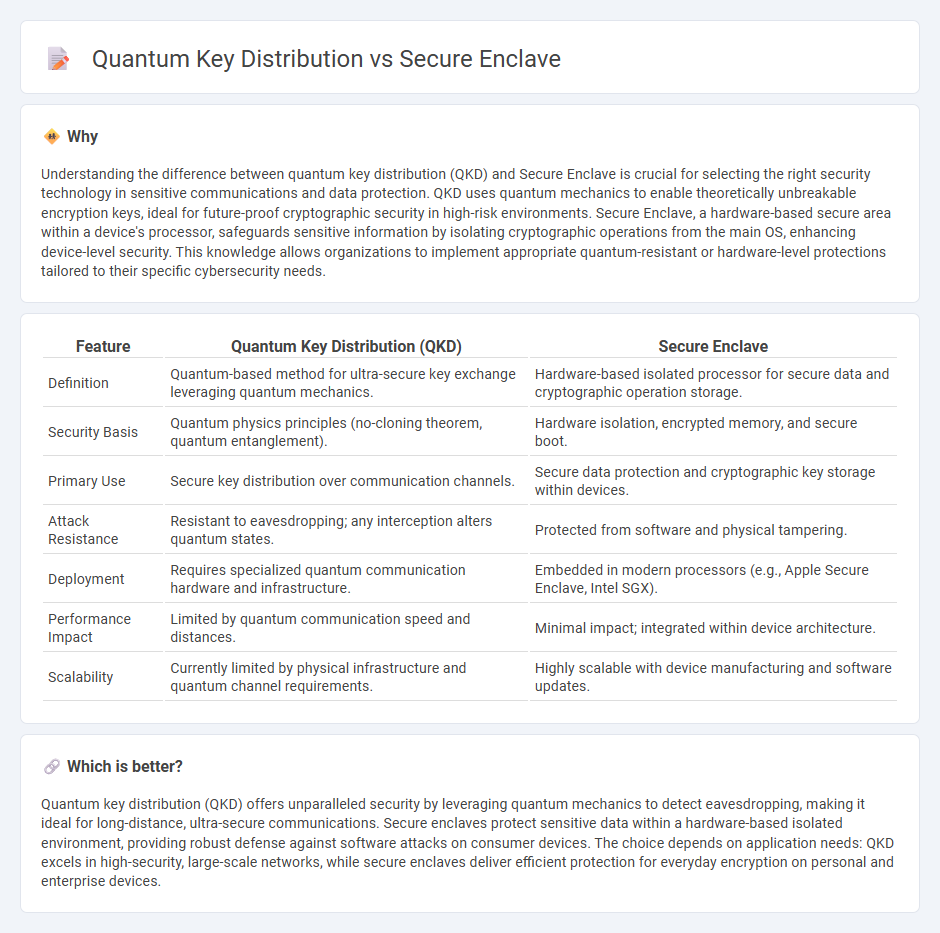
Quantum key distribution leverages quantum mechanics to enable theoretically unbreakable encryption by securely exchanging cryptographic keys, while Secure Enclave provides hardware-based isolation within devices to protect sensitive data and cryptographic operations. The primary advantage of quantum key distribution lies in its resistance to computational attacks, even from future quantum computers, whereas Secure Enclave enhances security by creating a trusted execution environment on existing hardware. Explore the fundamental differences and potential applications of these cutting-edge security technologies to understand their impact on data protection.
Why it is important
Understanding the difference between quantum key distribution (QKD) and Secure Enclave is crucial for selecting the right security technology in sensitive communications and data protection. QKD uses quantum mechanics to enable theoretically unbreakable encryption keys, ideal for future-proof cryptographic security in high-risk environments. Secure Enclave, a hardware-based secure area within a device's processor, safeguards sensitive information by isolating cryptographic operations from the main OS, enhancing device-level security. This knowledge allows organizations to implement appropriate quantum-resistant or hardware-level protections tailored to their specific cybersecurity needs.
Comparison Table
| Feature | Quantum Key Distribution (QKD) | Secure Enclave |
|---|---|---|
| Definition | Quantum-based method for ultra-secure key exchange leveraging quantum mechanics. | Hardware-based isolated processor for secure data and cryptographic operation storage. |
| Security Basis | Quantum physics principles (no-cloning theorem, quantum entanglement). | Hardware isolation, encrypted memory, and secure boot. |
| Primary Use | Secure key distribution over communication channels. | Secure data protection and cryptographic key storage within devices. |
| Attack Resistance | Resistant to eavesdropping; any interception alters quantum states. | Protected from software and physical tampering. |
| Deployment | Requires specialized quantum communication hardware and infrastructure. | Embedded in modern processors (e.g., Apple Secure Enclave, Intel SGX). |
| Performance Impact | Limited by quantum communication speed and distances. | Minimal impact; integrated within device architecture. |
| Scalability | Currently limited by physical infrastructure and quantum channel requirements. | Highly scalable with device manufacturing and software updates. |
Which is better?
Quantum key distribution (QKD) offers unparalleled security by leveraging quantum mechanics to detect eavesdropping, making it ideal for long-distance, ultra-secure communications. Secure enclaves protect sensitive data within a hardware-based isolated environment, providing robust defense against software attacks on consumer devices. The choice depends on application needs: QKD excels in high-security, large-scale networks, while secure enclaves deliver efficient protection for everyday encryption on personal and enterprise devices.
Connection
Quantum key distribution (QKD) uses principles of quantum mechanics to generate secure encryption keys, which can be enhanced by Secure Enclave technology that protects cryptographic keys within isolated hardware environments. Secure Enclaves provide a trusted execution environment, ensuring that keys generated through QKD remain confidential and resistant to tampering or extraction. The integration of QKD with Secure Enclave hardware strengthens overall cybersecurity by combining unbreakable quantum encryption with secure key storage and processing.
Key Terms
Trusted Execution Environment (TEE)
Trusted Execution Environment (TEE) offers a hardware-isolated secure enclave within a device, ensuring sensitive data and code remain protected from unauthorized access and tampering, making it essential for applications requiring strong security guarantees. Quantum Key Distribution (QKD), by contrast, utilizes the principles of quantum mechanics to enable theoretically unbreakable encryption keys transmitted over optical networks, but lacks the local execution trust layer provided by TEEs. Explore the comparative benefits and integration potential of TEEs and QKD for cutting-edge secure communication architectures.
Quantum Entanglement
Quantum entanglement powers quantum key distribution (QKD) by enabling secure encryption keys through interconnected quantum states, ensuring high-level communication security. Secure enclaves utilize hardware-based isolation for trusted execution environments, but lack the fundamental quantum properties that make QKD resistant to eavesdropping. Explore how quantum entanglement revolutionizes cryptographic security by delving deeper into the mechanics of QKD.
Post-Quantum Cryptography
Secure enclaves provide hardware-based isolated environments to protect sensitive data and cryptographic operations, while quantum key distribution (QKD) leverages the principles of quantum mechanics to enable secure key exchange impervious to quantum attacks. Post-Quantum Cryptography (PQC) focuses on developing algorithms resistant to quantum computational threats without relying on specialized hardware like secure enclaves or the physical infrastructure demands of QKD. Explore the latest advancements and practical implementations in PQC to understand the future of quantum-resistant cybersecurity solutions.
Source and External Links
What is a Secure Enclave? - Secure enclaves are hardware-level encrypted memory environments designed to isolate and protect code, data, and cryptographic operations from the host operating system and unauthorized users, even with root or physical access, and are available across Intel, AMD, and major cloud platforms.
Secure Enclave - Apple's Secure Enclave is a dedicated, isolated subsystem within select Apple devices that provides an extra security layer for sensitive data by separating cryptographic processes from the main processor and includes mechanisms for secure storage and hardware-based encryption.
What is a Secure Enclave? - The Secure Enclave is a certified hardware and low-level software security module embedded within a System-On-Chip, offering robust protection against both hardware and software threats and serving as a secure environment for cryptographic operations and sensitive data.
 dowidth.com
dowidth.com